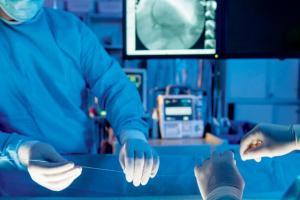Chances are that youll have an angioplasty to open a blocked artery in your heart. Youll be wide awake throughout. This is how it feels.

How on earth do you jiggle a wire blind through the intricate maze of the body's blood vessels to a precise point inside the heart? Pic/Getty Images
Will I be given an anaesthetic?" I asked Dr Cherian Varkey. They were going to do things to my heart the following day.
ADVERTISEMENT
"Oh, don't worry, you'll be wide awake," he replied. "We'll be asking you questions."
Dr Varkey is one of Karnataka's legendary cardiologists. He also represents a species of physician rarely encountered these days, a doctor who actually knows when to trust science and when to go with his gut, and who likes his research as long as a pinch of salt has been added.
I knew something was wrong back in 2004 in Nairobi, where we lived. I was grinding to a breathless halt after a mere 50 metres of jogging along a 400-metre track. At home, I was huffing and puffing after climbing just ten steps on the staircase.
I decided to go to Bengaluru and put myself in the hands of Dr Varkey, then a consultant at Wockhardt Hospital. He told me they'd have to get in there and take a look at my heart.
"We'll do an angiogram," he said, using a word I had never heard before. "If we find a blockage, we'll do an angioplasty and put in a stent." Two more new words.
Angioplasty is a procedure (not a surgery!) for removing a blockage in any blood vessel, often the heart, and usually entails inserting a stent, a kind of lattice or scaffolding that holds the artery open after they've cleared the blockage.
They would enter my blood vessel by inserting a wire into a fat vein in my groin, manipulate the wire till it reached the heart and then check things out. My doctor for the procedure was one of Dr Varkey's 5-star students, Dr Ranga Nayak, though of course, both doctors would be present.
No one told me they'd be casually chatting about their weekend plans while pushing things in and out of my heart.
If you're anything like me, this should be your question right now: how on earth do you jiggle a wire blind through the intricate maze of the body's blood vessels to a precise point inside the heart? It sounded like threading a needle after passing the string through a long straw first.
I was conscious on the table, looking up at a bank of monitors. It would probably take them at least ten minutes to grope their way to my heart, I thought, but Dr Ranga was reeling the guide wire into me like an angler with a tackle. In about 15 seconds, he had positioned it at a 'base camp' near the heart. He now slipped a catheter over the guide wire like a sheath, sliding it almost up to the base camp. The wire would lead the way and the catheter would follow.
I don't think the doctor once watched his hands. How did he do this so effortlessly? Of all people, a seagoing marine engineer explained it to me, comparing the body's veins and arteries to the complicated piping and plumbing of a ship. To reach a specific point with a ship, you'd have to work a wire right up to the problem point, but only two movements are available — you can push or pull the wire, or you can turn it left or right. Dr Ranga used his left hand for the in/out movements and his other hand for the left/right twists. And that was all he used, watching the x-ray monitor to calibrate his movements.
Suddenly a black dye spread on the screen, briefly outlining the heart's blood vessels. And there it was — 80 per cent of my big fat Left Anterior Descending artery was blocked with waxy fats.
What happened next was magic. The catheter inched into the blockage. A balloon opened up and fragmented the wax, which floated away in the blood. For that brief moment, that artery was fully blocked by the balloon — and I felt it. This is what a heart attack feels like. The doctors were watching me closely. This was why they needed me conscious.
The blockage gone, the stent wrapped tight around the catheter was unfurled within the blood vessel. It was done. I could go home the next day.
I had dinner with Dr Varkey the next night. No mean chef, he had whipped up a meal that would have made any cardiologist blanch: fatty pork floating in an orange-honey sauce, beef Viennoise with a layer of olive oil, noodles, a salad.
"You could have had a heart attack, but you didn't," he said, seeing my baffled face. "You're as good as new now. You could choose to live your life thinking of yourself as a heart patient. Or you could live with joy, be normal again. Don't overdo anything, but for heaven's sake, son, don't underdo anything either."
Here, viewed from there. C Y Gopinath, in Bangkok, throws unique light and shadows on Mumbai, the city that raised him. You can reach him at cygopi@gmail.com Send your feedback to mailbag@mid-day.com
The views expressed in this column are the individual's and don't represent those of the paper
Keep scrolling to read more news
Catch up on all the latest Mumbai news, crime news, current affairs, and a complete guide from food to things to do and events across Mumbai. Also download the new mid-day Android and iOS apps to get latest updates.
Mid-Day is now on Telegram. Click here to join our channel (@middayinfomedialtd) and stay updated with the latest news
 Subscribe today by clicking the link and stay updated with the latest news!" Click here!
Subscribe today by clicking the link and stay updated with the latest news!" Click here!







